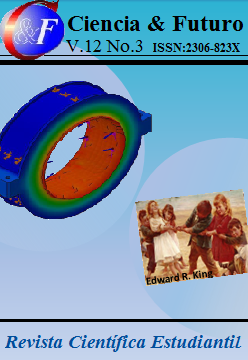Empleo del fenómeno de la fricción rotativa en máquina torno para la unión de aleaciones disímiles
Palabras clave:
fricción rotativa, disímil, forja, dureza.Resumen
Se obtuvo la unión metalúrgica entre la aleación de cobre Cu-DHP y el acero AISI 1045 a partir del fenómeno de la fricción rotativa con el empleo de una máquina herramienta torno. La unión se realizó con 1 400 r/min en barras de 12 mm de diámetro y 100 mm de longitud, se aplicó presión de soldadura de 30 MPa. Las variables del proceso fueron el tiempo de soldadura, la presión y el tiempo de forja. En la zona termomecánicamente afectada y la térmica afectada, se pudo determinar que, existe la fase α y β y óxido cuproso (Cu2O) en el lado del Cu-DHP y en el acero AISI 1045, la presencia de la fase austenítica residual, la martensita y fase α, producto de la interacción atómica entre ambas aleaciones. La dureza se incrementó desde 89,7 HV en el cobre y 180 HV en el AISI 1045 hasta 389 HV en la ZTMA.Descargas
Citas
BUFFA, G.; FRATINI, L.; PASTA, S. & SHIVPURI, R. 2008. On the thermo-mechanical loads and the resultant residual stresses in friction stir processing operations. CIRP Annals-Manufacturing Technology 57(1): 287-290.
GUZMÁN-ROMERO, E.; FERNÁNDEZ-COLUMBIÉ, T.; ALCÁNTARA-BORGES, D. & RODRÍGUEZ-GONZÁLEZ, I. 2017. Efecto de la velocidad angular y la presión en el proceso de soldadura por fricción radial en una aleación de aluminio AA 5754. Minería y Geología 33(3): 312-325.
KIMURA, M.; FUJI, A. & SHIBATA, S. 2015. Joint properties of friction welded joint between pure magnesium and pure aluminium with post-weld heat treatment. Materials and Design 85(10): 169-179.
KOTESWARA, P.; MOHAN, V.; SURYA, N. & KRISHNA, G. 2017. Effect of speed on hardness in rotary friction welding process. International Journal of Materials Science 12(4): 635-641.
LIANG, Z.; QIN, G.; WANG, L.; MENG, X. & LI, F. 2015. Microstructural characterization and mechanical properties of dissimilar friction welding of 1060 aluminum to AZ31B magnesium alloy. Materials Science and Engineering A 645(214): 170-180.
MAALEKIAN, M. & CERJAK, H. 2015. Modelling the orbital friction welding of pearlitic steel bars, Trends in Welding Research, Proceedings of the 8th conference, 736-741.
MERCAN, S.; AYDIN, S. & OZDEMIR, N. 2015. Effect of welding parameters on the fatigue properties of dissimilar AISI 2205–AISI 1020 joined by friction welding. International Journal of Fatigue. 81(12): 78-90.
MUMIN, S. 2016. Optimizing the parameters for friction welding stainless steel to copper Parts. Materials and technology 50(1): 109-115.
SESHAGIRIRAO, B.; SIVARAMAKRISHNA, V. & SAIKRISHNAPRASAD, G. 2015. Experimental investigation of rotary friction welding parameters of aluminum (H-30) and mild steel (AISI-1040). International Journal of Innovative Research in Science, Engineering and Technology 4(5): 2920-2925.
SHANJEEVI, C.; JESWIN. J.; ARPUTHABALAN, R.; DUTTA, D. & PRADEEP, S. 2017. Investigation on the effect of friction welding parameters on impact strength in dissimilar joints. Materials Science and Engineering 197(100): 3-7.
SRIRAM, R. & RAMADOSS. R. 2015. A study on mechanical and metallurgical properties of friction welded dissimilar materials. International Journal for Research in Applied Science & Engineering Technology (IJRASET) 3(1): 32-38.
SUPPACHAI, C.; CHAIYOOT, M. & MUHAMAD, T. 2017. Rotary friction welding of dissimilar joints between SSM 356 and SSM 6061 aluminum alloys produced by GISS. Engineering Journal 21(1): 181-191.
WEGLOWSKI, A. 2011. Friction stir processing-analysis of the process. Archives of metallurgy and materials 56(12): 779-788.
Publicado
Cómo citar
Número
Sección
Derechos de autor 2022 Ledennis Torres-Suárez, Tomás Fernández-Columbié, Yanelis Marzo-Herrera, Elis Guzmán-Romero

Esta obra está bajo una licencia internacional Creative Commons Atribución-NoComercial 4.0.
Esta obra está bajo una Licencia Creative Commons Reconocimiento-NoComercial 4.0 Internacional
La Revista Ciencia & Futuro es una revista de acceso abierto, todo el contenido está disponible gratuitamente sin cargo para el usuario o su institución. Los usuarios pueden leer, descargar, copiar, distribuir, imprimir, buscar o vincular los textos completos de los artículos, o utilizarlos para cualquier otro fin lícito, sin pedir permiso previo al editor o al autor. Todo lo anterior, de acuerdo con la definición de BOAI de acceso abierto.
Los autores que publican en esta revista están de acuerdo con los siguientes términos: Licencia Creative Commons Atribución-NoComercial permite que el beneficiario de la licencia tenga el derecho de copiar, distribuir, exhibir y representar la obra y hacer obras derivadas para fines no comerciales siempre y cuando reconozca y cite la obra de la forma especificada por el autor o el licenciante. Los autores pueden establecer por separado acuerdos adicionales para la distribución no exclusiva de la versión de la obra publicada en la revista (por ejemplo, situarlo en un repositorio institucional o publicarlo en un libro), con un reconocimiento de su publicación inicial en esta revista. Se permite y se anima a los autores a difundir sus trabajos electrónicamente (por ejemplo, en repositorios institucionales o en su propio sitio web) antes y durante el proceso de envío, ya que puede dar lugar a intercambios productivos, así como a una citación más temprana y mayor de los trabajos publicados (Véase The Effect of Open Access) (en inglés). Lo anterior debe realizarse siempre sobre el artículo ya publicado por Ciencia & Futuro.
Los autores mantienen el control sobre la integridad de sus trabajos y el derecho a ser adecuadamente reconocidos y citados.
A los editores se les otorgan derechos no exclusivos para publicar y distribuir.







